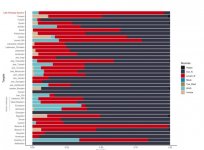The two Islamic samples from Syria are closest to Bedouin B and Saudis (not to the nearby Levantine populations like the Lebanese, Druse, Jordanians, or , for example), and all three carry very high levels of Levant Neolithic. The early Muslims and Bedouin B are over 90% Levant Neolithic. I was surprised to see that the Saudis are 36.1 Iran Neo. I also expected more than .5 Yoruba, given their appearance.
The two historic Syrian samples derive the majority of their ancestry from Neolithic Levantine populations (Levant_N, 91.3%) as well as minor proportions from Neolithic Iran (Iran_N, 4.1%) and European hunter-gatherers (WHG, 4.6%). Bedouin B are almost entirely derived from Levant_N (98.7%), with a very small percentage from Iran_N. Saudi derived more than half of their ancestry from Levant_N (63.4%), and the rest from Iran_N (36.1%) and Yoruba (0.5%). These results show that all three groups have high contributions from Neolithic Levantine groups but at different proportions, supporting the general observation of similarities between them but also consistent with a lack of a direct match to the Late Antiquity Syrian individuals in our modern reference panel (Supplementary Fig. S3).
As to Bedouin A and Bedouin B, both sets of samples are from the Negev in Israel.
“It is suggested that the Negev Bedouins originate from a small founder population and most of their ancestors migrated from the Arabian Peninsula to the Negev and Sinai regions around 700 CE, i.e., shortly after the spread of Islam46. Similar migration events have been recorded, including for the Tell Qarassa region, which was controlled by the city of Bostra, an important settlement in southern Syria during the Roman and Byzantine empires47. This area was occupied by the Ghassanids, a nomadic group from the South Arabian Peninsula that arrived at the end of the fifth century and became Byzantium's principal Arab ally48 during the early sixth century, ruling a large Christian population. This period saw an influx of Islamic Arabs along with other migrants, many of which maintained a nomadic lifestyle49. It is clear that the Late Antiquity in the Levant, were highly dynamic times driven by Arab migrations to the Levant, mirrored by clan-structured groups such as Bedouins. Within this framework, our two Syrian samples could potentially represent part of one of these highly structured nomadic tribes that arrived in the Levant from Arabia under strict cultural, social and religious rules.”
“The Tell Qarassa graves differ from most other excavated examples of early Islamic burials because they were not located in a cemetery and – from the available evidence- do not seem to have been located near a permanent settlement of the period. From studies of nomadic Bedouin it appears that when someone dies they are buried immediately in a prominent nearby location50 . There are a number of aspects of the Tell Qarassa burials which can be documented in Bedouin burials both from the recent and more distant past (Supplementary Text S1 – Bedouin Burials). Based on this information and also taking into account the genetic results it seems likely that the deceased were Bedouin”
The small genetic differences observed between these two groups suggest a slightly different trajectory and contacts with other groups since the Neolithic. The clear distinction between syr005 and syr013 from modern Levantine populations combined with the evident genetic similarity to Neolithic Levantine individuals posits an interesting genetic picture that can be explained under two alternative scenarios: 1) a long-term continuity followed by genetic isolation due to strong social, cultural and religious barriers resulting from the Islamisation of the region during the Early Islamic period or 2) the result of a past migration from the Arabian Peninsula. Under the first scenario, syr005 and syr013 would exemplify a group representing long-term local continuity since the Neolithic that would have converted to Islam relatively early after the Arab expansion took place. Hence, the original genetic structure of the region would have been conserved due to strong social, cultural and religious barriers over time preventing mixing with neighbouring populations, resulting in the highly drifted population observed in our data. Long-term genetic continuity has been suggested for various Levantine populations, such as for modern Lebanese which are found to be genetically similar to Bronze Age populations from the region9 , as well as for present-day populations which have been reported to retain ancestry from local populations despite admixture events such as the Crusades in the Middle Ages12 . Under the second scenario, our data is best explained by migration from the Arabian Peninsula to the Levant, a scenario concordant with historical records of a migration from the Arabian Peninsula to the region not long before the time of our two Late Antiquity Syrians (i.e. 7th and 8th centuries) (see above and Supplementary Text S1 – Early Islamic Southern Syria). Moreover, the presence of Neolithic Levantine ancestry in modern-day populations from the Arabian Peninsula seems to support this scenario. If we assume that Neolithic Levantine ancestry was already present in the Arabian Peninsula during historic times or earlier, we would expect to see a reintroduction of Neolithic Ancestry into the Levant where this would have been diluted due to the multi-layered history during the previous millennia. The remarkable affinity to Arabian and Neolithic ancestry would have been maintained overtime as a result of the traditional clan structure of Arab tribes.”
I would go with Option 2.
I find it very interesting that although the Bedouin have been considered in the past the “original” Arabs, they are marginalized. Also, when and from whom did the other Saudi tribes get the Iran Neo. Was it with the arrival millennia ago of their J1?
There are some graphics and charts at the end of the paper, but until I take a look at the Supplement and the math, color me a bit skeptical, especially as some statistical methods weren’t used.. Anatolian Neolithic is half Levantine Neolithic, with the rest divided between Iranian Neolithic and WHG like?


